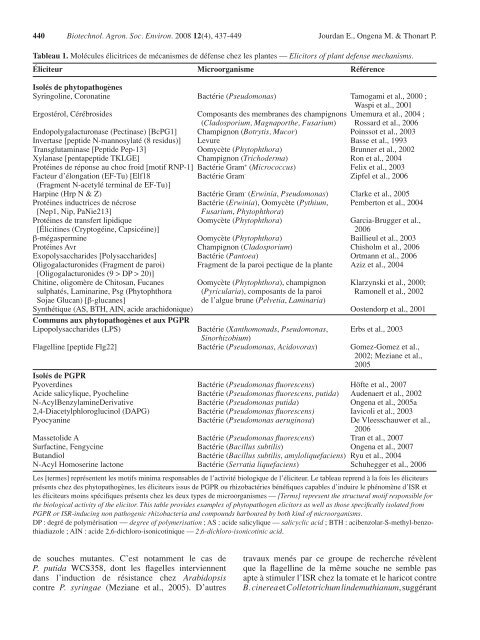Caractéristiques moléculaires de l'immunité des plantes induite par ...
Caractéristiques moléculaires de l'immunité des plantes induite par ...
Caractéristiques moléculaires de l'immunité des plantes induite par ...
You also want an ePaper? Increase the reach of your titles
YUMPU automatically turns print PDFs into web optimized ePapers that Google loves.
440 Biotechnol. Agron. Soc. Environ. 2008 12(4), 437-449 Jourdan E., Ongena M. & Thonart P.<br />
Tableau 1. Molécules élicitrices <strong>de</strong> mécanismes <strong>de</strong> défense chez les <strong>plantes</strong> — Elicitors of plant <strong>de</strong>fense mechanisms.<br />
Éliciteur Microorganisme Référence<br />
Isolés <strong>de</strong> phytopathogènes<br />
Syringoline, Coronatine Bactérie (Pseudomonas) Tamogami et al., 2000 ;<br />
Waspi et al., 2001<br />
Ergostérol, Cérébrosi<strong>de</strong>s Composants <strong>de</strong>s membranes <strong>de</strong>s champignons Umemura et al., 2004 ;<br />
(Cladosporium, Magnaporthe, Fusarium) Rossard et al., 2006<br />
Endopolygalacturonase (Pectinase) [BcPG1] Champignon (Botrytis, Mucor) Poinssot et al., 2003<br />
Invertase [pepti<strong>de</strong> N-mannosylaté (8 residus)] Levure Basse et al., 1993<br />
Transglutaminase [Pepti<strong>de</strong> Pep-13] Oomycète (Phytophthora) Brunner et al., 2002<br />
Xylanase [pentapepti<strong>de</strong> TKLGE] Champignon (Tricho<strong>de</strong>rma) Ron et al., 2004<br />
Protéines <strong>de</strong> réponse au choc froid [motif RNP-1] Bactérie Gram + (Micrococcus) Felix et al., 2003<br />
Facteur d’élongation (EF-Tu) [Elf18 Bactérie Gram - Zipfel et al., 2006<br />
(Fragment N-acetylé terminal <strong>de</strong> EF-Tu)]<br />
Harpine (Hrp N & Z) Bactérie Gram - (Erwinia, Pseudomonas) Clarke et al., 2005<br />
Protéines inductrices <strong>de</strong> nécrose Bactérie (Erwinia), Oomycète (Pythium, Pemberton et al., 2004<br />
[Nep1, Nip, PaNie213] Fusarium, Phytophthora)<br />
Protéines <strong>de</strong> transfert lipidique Oomycète (Phytophthora) Garcia-Brugger et al.,<br />
[Élicitines (Cryptogéine, Capsicéine)] 2006<br />
β-mégaspermine Oomycète (Phytophthora) Baillieul et al., 2003<br />
Protéines Avr Champignon (Cladosporium) Chisholm et al., 2006<br />
Exopolysacchari<strong>de</strong>s [Polysacchari<strong>de</strong>s] Bactérie (Pantoea) Ortmann et al., 2006<br />
Oligogalacturoni<strong>de</strong>s (Fragment <strong>de</strong> <strong>par</strong>oi) Fragment <strong>de</strong> la <strong>par</strong>oi pectique <strong>de</strong> la plante Aziz et al., 2004<br />
[Oligogalacturoni<strong>de</strong>s (9 > DP > 20)]<br />
Chitine, oligomère <strong>de</strong> Chitosan, Fucanes Oomycète (Phytophthora), champignon Klarzynski et al., 2000;<br />
sulphatés, Laminarine, Psg (Phytophthora (Pyricularia), composants <strong>de</strong> la <strong>par</strong>oi Ramonell et al., 2002<br />
Sojae Glucan) [β-glucanes] <strong>de</strong> l’algue brune (Pelvetia, Laminaria)<br />
Synthétique (AS, BTH, AIN, aci<strong>de</strong> arachidonique) Oostendorp et al., 2001<br />
Communs aux phytopathogènes et aux PGPR<br />
Lipopolysacchari<strong>de</strong>s (LPS) Bactérie (Xanthomonads, Pseudomonas, Erbs et al., 2003<br />
Sinorhizobium)<br />
Flagelline [pepti<strong>de</strong> Flg22] Bactérie (Pseudomonas, Acidovorax) Gomez-Gomez et al.,<br />
2002; Meziane et al.,<br />
2005<br />
Isolés <strong>de</strong> PGPR<br />
Pyoverdines Bactérie (Pseudomonas fluorescens) Höfte et al., 2007<br />
Aci<strong>de</strong> salicylique, Pyocheline Bactérie (Pseudomonas fluorescens, putida) Au<strong>de</strong>naert et al., 2002<br />
N-AcylBenzylamineDerivative Bactérie (Pseudomonas putida) Ongena et al., 2005a<br />
2,4-Diacetylphloroglucinol (DAPG) Bactérie (Pseudomonas fluorescens) Iavicoli et al., 2003<br />
Pyocyanine Bactérie (Pseudomonas aeruginosa) De Vleesschauwer et al.,<br />
2006<br />
Massetoli<strong>de</strong> A Bactérie (Pseudomonas fluorescens) Tran et al., 2007<br />
Surfactine, Fengycine Bactérie (Bacillus subtilis) Ongena et al., 2007<br />
Butandiol Bactérie (Bacillus subtilis, amyloliquefaciens) Ryu et al., 2004<br />
N-Acyl Homoserine lactone Bactérie (Serratia liquefaciens) Schuhegger et al., 2006<br />
Les [termes] représentent les motifs minima responsables <strong>de</strong> l’activité biologique <strong>de</strong> l’éliciteur. Le tableau reprend à la fois les éliciteurs<br />
présents chez <strong>de</strong>s phytopathogènes, les éliciteurs issus <strong>de</strong> PGPR ou rhizobactéries bénéfiques capables d’induire le phénomène d’ISR et<br />
les éliciteurs moins spécifiques présents chez les <strong>de</strong>ux types <strong>de</strong> microorganismes — [Terms] represent the structural motif responsible for<br />
the biological activity of the elicitor. This table provi<strong>de</strong>s examples of phytopathogen elicitors as well as those specifically isolated from<br />
PGPR or ISR-inducing non pathogenic rhizobacteria and compounds harboured by both kind of microorganisms.<br />
DP : <strong>de</strong>gré <strong>de</strong> polymérisation — <strong>de</strong>gree of polymerisation ; AS : aci<strong>de</strong> salicylique — salicyclic acid ; BTH : acibenzolar-S-methyl-benzothiadiazole<br />
; AIN : aci<strong>de</strong> 2,6-dichloro-isonicotinique — 2,6-dichloro-isonicotinic acid.<br />
<strong>de</strong> souches mutantes. C’est notamment le cas <strong>de</strong><br />
P. putida WCS358, dont les flagelles interviennent<br />
dans l’induction <strong>de</strong> résistance chez Arabidopsis<br />
contre P. syringae (Meziane et al., 2005). D’autres<br />
travaux menés <strong>par</strong> ce groupe <strong>de</strong> recherche révèlent<br />
que la flagelline <strong>de</strong> la même souche ne semble pas<br />
apte à stimuler l’ISR chez la tomate et le haricot contre<br />
B. cinerea et Colletotrichum lin<strong>de</strong>muthianum, suggérant











